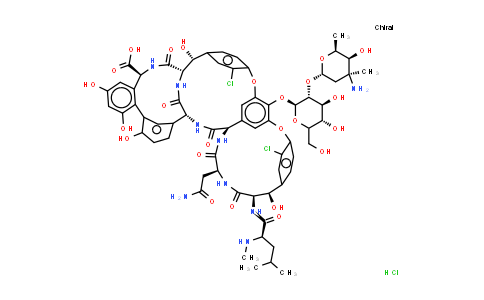| Chemical Name |
Vancomycin (hydrochloride) |
| CAS Number |
1404-93-9 |
| MDL Number |
MFCD03613611 |
| Molecular Formula |
C66H76Cl3N9O24 |
| Molecular Weight |
1485.71 |
Introduction of 1404-93-9 :
Vancomycin hydrochloride is an antibiotic for the treatment of bacterial infections. It acts by inhibiting the second stage of cell wall synthesis of susceptible bacteria. Vancomycin also alters the permeability of the cell membrane and selectively inhibits ribonucleic acid synthesis. IC50 & Target: Bacterial[1] In Vitro: Vancomycin is a large glycopeptide compound with a molecular weight of 1450 Da[1]. Vancomycin is a unique glycopeptide structurally unrelated to any currently available antibiotic. It also has a unique mode of action inhibiting the second stage of cell wall synthesis of susceptible bacteria. Vancomycin is active against a large number of species of Gram-positive bacteria, such as Staphylococcus aureus, Staph. epidermidis, Str. agalactiae, Str. bovis, Str. mutans, viridans streptococci, enterococci[2]. In Vivo: Vancomycin is administered intravenously, with a standard infusion time of at least 1 h, to minimize infusion-related adverse effects. Subjects with normal creatinine clearance, vancomycin has an α-distribution phase of 30 min to 1 h and a β-elimination half-life of 6-12 h. The volume of distribution is 0.4–1 L/kg. The binding of vancomycin to protein ranges from 10% to 50%. Factors that affect the overall activity of vancomycin include its tissue distribution, inoculum size, and protein-binding effects[1]. Vancomycin treatment of infected mice is associated with improved clinical, diarrhea, and histopathology scores and survival during treatment[3].
| Purity |
NLT 98% |
| Storage |
at 20ºC 2 years |
*The above information is for reference only.
